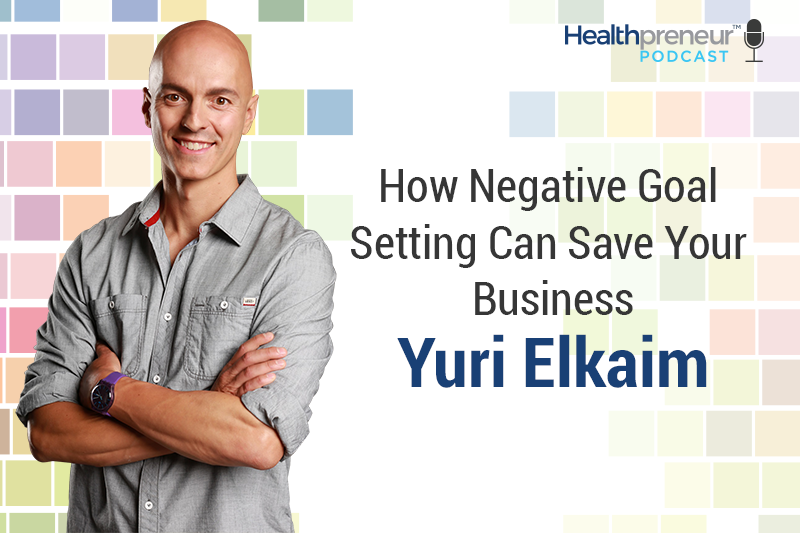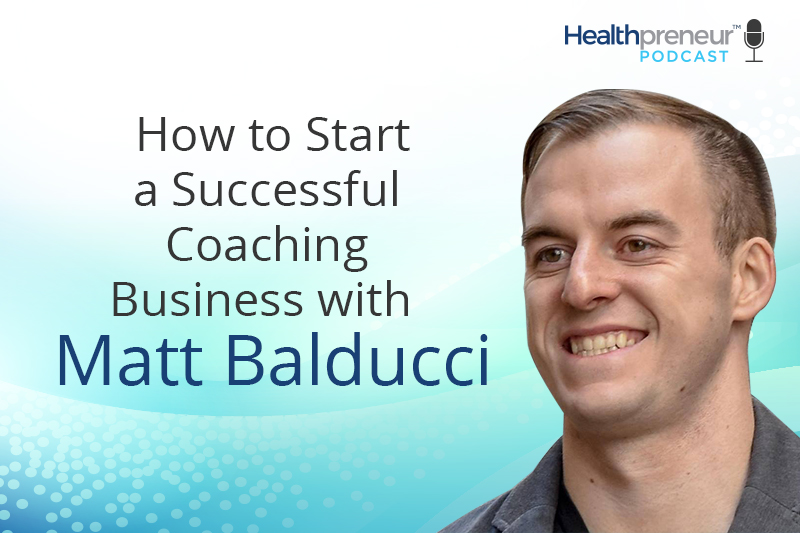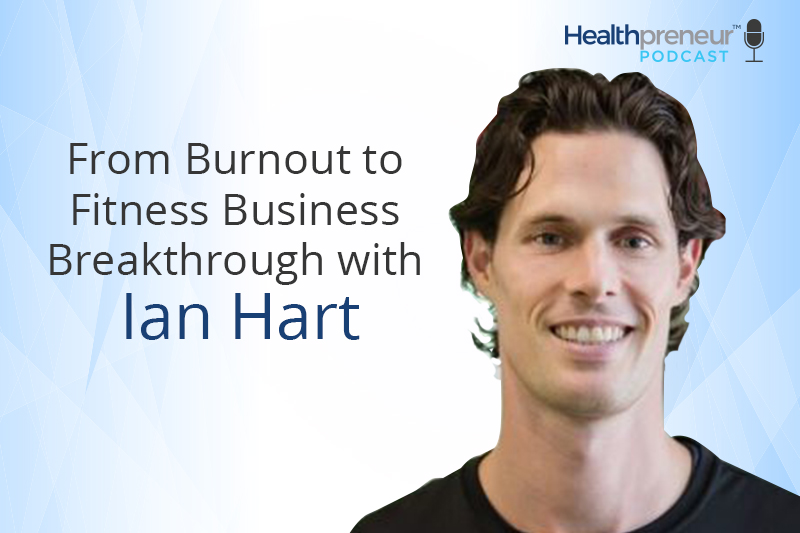How Negative Goal Setting Can Save Your Business

Happy New Year from all of us at Healthpreneur! I hope you’re ready to get back into the swing of things, because today I’ve got a great solo round for you.
I want you to dive into 2018 with your best foot forward, and in order to do that we need to talk about negative goal setting!
Yes, you heard me right. Negative goal setting—it’s not as weird as it sounds, trust me. This is a relatively unknown term but once you understand what I’m talking about, it makes a lot of sense and it can make a huge difference in the way your business operates.
So, without further ado—let’s just get into the episode. There is a ton of great info here, packed into one quick podcast. I would highly recommend you check this one out.
In this episode I discuss:
1:00 – 8:00 – “Solution before the problem”
8:00 – 13:00 – Nine different upsell flows?
13:00 – 17:00 – The Nine Business Accelerators Webinar
Transcription
Happy New Year and welcome to 2018! Yuri Elkaim here, and welcome to the Healthpreneur podcast, 2018 edition. It is Monday, January 1st. It might be freezing cold and full of snow where you are, or maybe you’re in sunshine and warm—I don’t know. But I’m in Toronto. A little bit chilly, but it’s been a great holiday season.
I hope you had an amazing holiday and a great New Years. Hopefully you’re not too hungover and you’re ready to kick things off on the right foot.
So, on Saturday we did a bonus session, which was called “The Year Ahead.” We planned out your year in 2018, to make it as fruitful and focused as possible.
And today, I want to walk you through how negative goal setting can actually save your business.
Yeah, it’s kind of weird, right? We talked about how to properly set goals on the bonus session and today I’m going to show you how negative goal setting can actually help you as well.
The Solution Before the Problem
So, what the heck is negative goal setting? Well, it’s kind of an unknown term. I don’t know if many people think about this, but this is something I learned as an athlete. I think the first time I really started to think about this was when I was 17 and I was playing with a great soccer team in Toronto.
We were one of the best teams in Canada. We traveled to Italy and played some amazing teams over there and we always did really, really well. And our coach—other than being a tyrant and throwing garbage cans around at us half time, yelling and screaming from the sidelines, which is always fun—one of the things he used to say was, “Solution before the problem.”
“Solution before the problem.”
What does that even mean? Well, that’s where negative goal setting comes in. In the context of soccer, “solution before the problem” means that when someone passes you the ball, you need to know what you’re gonna do with the ball before you even receive it.
It’s another level of thinking, right? And that’s one of the biggest differences between the different divisions in soccer. So every country—mostly in Europe, I guess—has divisions. In England they have the Premiership, the top flight of football. Then there’s the Championship, which is the second division, then there’s a third division, fourth division, and each of those divisions gets weaker and weaker, right?
The major difference between those divisions is usually the speed of thinking and execution of those players. So yes, there are players that are talented. You’ve got guys like Leo Messi and Neymar, who are just freaks of nature when it comes to talent—but on average, those who are able to think quickly and make fast decisions are usually more successful than those who are slower. And that’s a big difference between the different levels of play.
So, in terms of business, how we can we think more quickly on our feet so that we’re not caught off-guard when things don’t go as planned? That’s where having a solution before the problem comes in.
So negative goal setting is this: Negative goal setting is essentially … and it’s kind of counter intuitive because I’m a huge believer in focusing on what you want and visualizing what you want.
Because when you focus, you get what you focus on. I’m totally for that.
However, I’m also a big fan of this idea of visualizing plan B and C, so they don’t surprise you if they do happen.
Mike Tyson has one of the best quotes of all time, I think: “Everyone has a plan until they get punched in the face.”
And that is so true at so many levels—in business and in life. And that’s why I can’t stand when people go on “Shark Tank” and they’re like, “What are your projections for the next year?” “Oh, we project we’re gonna go from $135,000 to $540,000 in revenue.”
How on earth are you projecting that? I can’t even project what’s going to happen next month in my business—and that’s not quite true, but it’s very tough to make an accurate projection like that. It’s ridiculous, right? Unless you have recurring members at a specific price and their fixed in for a year.
It’s great to have a plan, it’s great to walk into the bank with a neat, tidy business plan … But then when none of that actually comes to fruition, you’re like, “What the hell did we do? Okay, that didn’t work out, what do we do instead?”
So what negative goal setting does is help you focus on, “Okay, this is the ideal scenario, this is the ideal visualized path we want to go from here to here, but what happens if something goes wrong.”
Let’s just use the example of climbing a mountain. So we’re climbing a mountain. We know we want to get to the summit, we know we have to get to base camp one, base camp two and so forth.
But what happens if we’re going from base camp one to base camp two and all of a sudden there’s a full-on whiteout? The weather comes in, the clouds come in—you can’t see anything.
What do you do in that scenario? Most people just freak out on the spot, because they haven’t thought of plan B.
So, what I want you to think about with your goals, the things you’re working on—your product launch, live event, book, whatever it is—think of the things that can go wrong and solve them before they do.
I’m telling you, if you do this on a consistent basis, with any aspect of your business, you will have a frictionless ride to the goal.
Nine different upsell flows?
I’ll give you an example. One of the recent launches we had was for our free cookbook. This is on the health and fitness business. We have a free-plus-shipping offer for our cookbook, and it did really, really well.
We did the product launch two years ago. At this time I kind of figured out this whole thing—I’d made a lot of mistakes, I kind of had things figured out a bit more by this point. So I said, “Our number one goal is to maximize cart value, so that our affiliates and joint venture partners continue promoting this because it just makes sense for them.”
Now, instead of waiting for a bunch of traffic to come through and look at the upsell flow, look at how the cart value is doing and then try something new … We predetermined nine different upsell flows.
Yeah, nine different upsell flows.
Normally, you have an upsell flow—which is, you buy the product, upsell one, upsell two, upsell three if you want, thank you pitch. That’s what normally happens, right?
But we decided to say, “Well, we know that might not be the winner. This upsell might not perform well and this one might not perform well, this one might. So, let’s craft nine other variations.”
We crafted those nine other upsell flows. All the pages were done. What that allowed us to do was, ahead of time, set up the split test so that when traffic came to the site, everything was ready to go.
So we had planned for specific upsells not working. We had planned for the cart value not being as high as we wanted. And this is so funny, because people freak out when they do product launches.
They’re up all day—26 hours a day, they don’t sleep. I’m like, “Why?”
I don’t know. We just have things ready. I walk my kids to school, I pick them up, the product launch is going great. There may have been a couple hiccups. Our team supported people where they needed to and it’s just kind of business as usual.
And the only reason that’s possible is because we had negative goal setting built into that launch. We just said, “Okay, well what happens if this doesn’t happen? What happens if this doesn’t go to plan? Let’s build in contingencies.”
I love flying, as I’ve mentioned before. Airplanes are a great example of this. Most airplanes have three to four redundancies—which means if the hydraulic system fails, the electrical system will take over. If the electrical system fails, then the manual system will take over.
So the pilot and crew are never in a situation where it’s like, “Oh my God, the electrical system failed, the plane is gonna crash!” Planes are a great example of multiple redundancies. If one thing fails, something else kicks in to take its spot.
That is what negative goal setting can do for your business.
I’m telling you, this is one of the most powerful things you can get into doing. Whatever you’re thinking of doing—if it’s a launch, a specific program you’re releasing, a Facebook ad campaign, this is especially important.
And it is very important if you’re spending money to acquire traffic, because here’s the thing: I can give you the funnel. I can give you the ad, the funnel, the landing pages, but guess what? I guarantee there’s gonna be some discrepancy between my results and your results.
And that’s because you have a different offer, a different way of presenting it. You might be different on camera if you’re doing video stuff, you might be talking to a different demographic or audience.
So the framework is solid, but there’s little nuances that we have to account for.
If you can go into, let’s say, a Facebook ad campaign—and before you even hit submit, you’re thinking in your mind, “What happens if this ad doesn’t convert the way we want it to? What happens if the cost per click is too high? What happens if the cost per lead is too high? Where are the potential leaks in the funnel?”
Well, if the cost per lead is too high, maybe the ad copy is not as strong. Well, let’s have a look at the ad copy. Is the click-through rate too high or is the click-through rate too low? If it’s too low, then we know that’s one thing we can work on, but work on that ahead of time.
Create multiple angles of copy so that if low click-through rate is the issue, then you just swap that out or split test that against another ad variation.
If the click-through is high, but the cost per lead is high—then you know that the issue is most likely on the landing page. In this case, before you launch, have one, two, maybe three variations of a landing page. Maybe a slightly different layout, different headline, so that you can split test on the fly or ahead of time before being caught off guard when you go live.
Because this is money, right? Time is money. You don’t want to be wasting your money for days and then trying to figure things out after.
Think of the things that could go wrong, have a solution before the problem and you’ll be so much farther ahead.
You will thank me for this one. I’m telling you, this is a big one. That’s why I’m sharing it with you at the beginning of this year.
The Nine Business Accelerators Webinar
So, if you’ve enjoyed this, I’ve got something else for you. We’ve got a brand new webinar called, “The Nine Business Accelerators.” This is an online training, totally free, and the reason I put this together is because over the years I’ve noticed that, in business, there are a lot of possible things we can be doing.
All sorts of different business models, different things we can focus on. And what I love to do is simplify life, simplify business, simplify health. What I’ve done over the past couple years is, I’ve looked at businesses from a 30,000 foot view and said, “Okay. This person is doing coaching, this person is selling supplements, this person is selling eBooks and courses. What are the commonalities? What are the things that they all have in common?”
What I’ve discovered is that there are nine power moves, nine categories, if you will, that have to take place in your business for it to thrive. You might be able to get away with one or two, maybe—but if you’re missing three, four, five of them, your business is gonna suffer. If you don’t have some of those dialed in, you’re gonna suffer.
So, I believe I’ve done a really good job at identifying, “Okay, well, if your problem is you want more customers, that’s fine because that falls into this particular business accelerator and here’s how we fix that problem.”
What I’d like to share with you in this webinar are these nine business accelerators and how you can, first and foremost, become aware of them and see how they overlap on your business. And no matter what your business model is, no matter what product or service you’re selling, it will fit in your business. This is just a time-tested and true framework.
I’m gonna walk you through what these nine are in the webinar. I’m gonna show you how to deploy them in your business. And once you have these figured out, they will give you more clarity, more customers and more profit.
Think of it like this. It’s like having a roadmap to the treasure—like in “Pirates of the Caribbean.” You have a map that shows you exactly how to get the gold treasure. That’s what these nine business accelerators do—they show you how to scale your business and how to go from where you are to where you want to be. They help you identify where you are in your business, what might be lacking and how to really fill those gaps.
So, if you’d like to go through this free training, then head on over to healthpreneurgroup.com/9, and you can register for the webinar there. It’s my free gift to you, but here’s the thing; I’m only running this online webinar during the first two-and-a-half weeks of this month.
So this is not something that’s gonna be around till the end of time, at least I don’t believe so. Okay, so if you want to register for this webinar, go over to healthpreneurgroup.com/9. I’ll walk you through the nine business accelerators. You’ll have more clarity, more customers, and more profit as a result. And if you’ve enjoyed this negative goal setting thing, that’s just the tip of the iceberg.
So register for that today. It’s awesome.
Thank you so much for joining me on this episode of the Healthpreneur podcast. We’ve got a really cool episode for you on Wednesday with Scott Rewick, who’s gonna show you how to grow your business 10 times with Facebook ads.
Scott is a colleague and friend of mine. I’ve known him for a number of years. He is crushing it online—he has one of the biggest paleo followings in the business, and it’s amazing what they’ve done in the past couple years.
He’s going to share some of his secrets, so do not miss that one. That’s coming on Wednesday and once again, if you haven’t subscribed to the podcast, then please do so today. Healthpreneur podcast on iTunes—just click the subscribe button so you don’t miss any of our awesome episodes coming your way.
So that’s all for today, but again, thank you so much for joining in. I hope this gets you on the right foot to start making 2018 your best year ever. Join me for our “Nine Business Accelerators” workshop over at healthpreneurgroup.com/9, completely free to attend. I guarantee it’ll be worth your time and I look forward to seeing you in our next episode on Wednesday.
In the meantime, continue to be great, do great and we’ll see you then.
If you enjoyed this episode, head on over to iTunes and subscribe to Healthpreneur™ Podcast if you haven’t done so already.
While you’re there, leave a rating and review. It really helps us out to reach more people because that is what we’re here to do.
What You Missed
In the last episode, we did a bonus session, which was called “The Year Ahead,” where we planned out your year in 2018, to make it as fruitful and focused as possible.
I showed you how to gain a lot of focus and clarity on what exactly you need to do in 2018 to take your business to the next level.
You’ll definitely want to grab a piece of paper when you listen to The Year Ahead episode.
Related posts
November 20, 2017
The 2-Letter Word That Will Transform Your Business
Today we’ve got a solo round on…
August 1, 2018
How to Start a Successful Coaching Business with Matt Balducci
Our last episode was a solo…
August 3, 2018
From Burnout to Fitness Business Breakthrough with Ian Hart
Welcome to the Healthpreneur…





